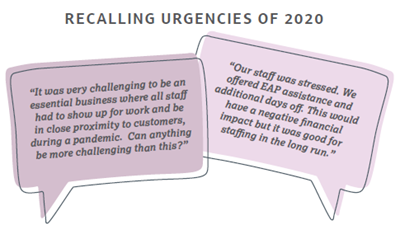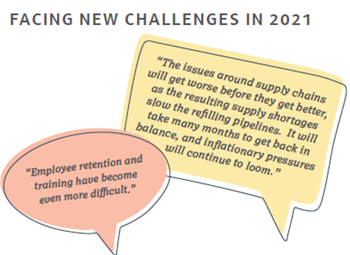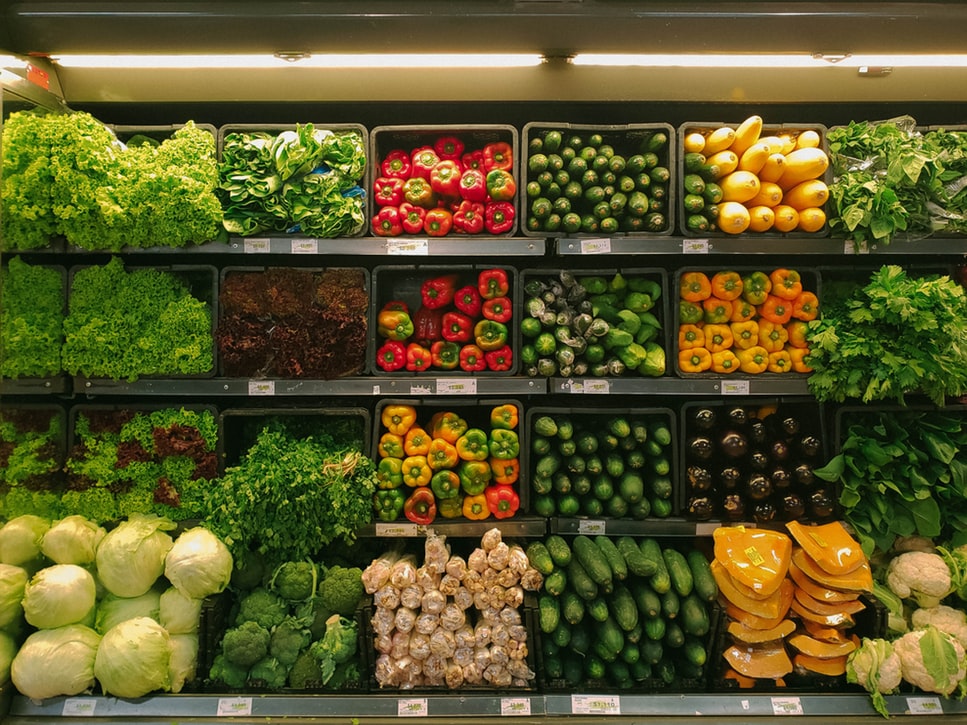By Steve Markenson, Director, Research & Insights, FMI
When I was younger, I used to enjoy roller coasters for their ability to deliver thrills and excitement. Nowadays, I am far more likely to feel anxiety about those wild rides—which leads me to a point about the pandemic. Food industry leaders have surely felt a great deal of anxiety about the crazy ride they have been on for the past 18 months, which seems to not have an end in sight. Nevertheless, the entire food retailing industry has shown enormous courage in overcoming daunting and unprecedented challenges.
excitement. Nowadays, I am far more likely to feel anxiety about those wild rides—which leads me to a point about the pandemic. Food industry leaders have surely felt a great deal of anxiety about the crazy ride they have been on for the past 18 months, which seems to not have an end in sight. Nevertheless, the entire food retailing industry has shown enormous courage in overcoming daunting and unprecedented challenges.
The story of this ongoing wild ride is relayed in the just released 2021 edition of FMI’s The Food Retailing Industry Speaks (Speaks). The report, based on feedback from a comprehensive survey of the industry, presents important findings on timely topics such as supply chain, workforce and technology.
Technology Acceleration
Speaks shows that food retailers advanced their technology strategies while the COVID-19 pandemic led consumers to pursue dramatically different shopping behaviors. From online shopping to micro-fulfillment and ghost kitchens, retailers quickly stepped up their technology games in 2020 — and are still doing so. More than 80% of food retailers surveyed are continuing to experiment with their ecommerce strategies. About 11% are already using micro-fulfillment, more than doubling in one year, with another 15% expecting to do so this year.
Workforce Challenges
 Frontline food retail workers heroically stepped up during the pandemic — and it’s not surprising that much of the early focus was on keeping workforces safe. Over time, higher employee turnover led retailers to put more emphasis on recruitment and retention. Strategies implemented for full-time and part-time employees ranged from better wages and salaries (85% full-time, 77% part-time) and bonuses (62%, 29%) to training and skills development (65%, 56%). Food retailers spent an average of almost $300 per employee in 2020 for training and development, and about two-thirds of retailers expect that amount will increase in 2021.
Frontline food retail workers heroically stepped up during the pandemic — and it’s not surprising that much of the early focus was on keeping workforces safe. Over time, higher employee turnover led retailers to put more emphasis on recruitment and retention. Strategies implemented for full-time and part-time employees ranged from better wages and salaries (85% full-time, 77% part-time) and bonuses (62%, 29%) to training and skills development (65%, 56%). Food retailers spent an average of almost $300 per employee in 2020 for training and development, and about two-thirds of retailers expect that amount will increase in 2021.
Supply Chain Hurdles
Supply chain has been marked by an especially white-knuckle ride during the pandemic. Surging consumer demand in 2020 led to major product shortages. By 2021, the food industry was feeling whiplash over supply chain bottlenecks that have impacted everything from ingredients to equipment. Trucking and transportation capacity has been particularly hard-hit, with some two-thirds of Speaks survey respondents saying this was having a negative impact on their businesses.
Lots More to the Story
This year’s Speaks relays many additional story lines about the industry’s pandemic ride, including details on proactive strategies. Food retailers have stepped up with new types of meal solutions, goals and implementation time frames for social responsibility efforts and growing support for communities. You can read all about it by downloading the Speaks report, which includes a list of 10 key takeaways.
I especially enjoy the quotes from survey respondents sprinkled throughout Speaks. Here’s one from a retailer commenting on what lies ahead.
“The issues around supply chains will get worse before they get better…It will take many months to get back in balance, and inflationary pressures will continue to loom.”
In other words, hold on tight for more of a bumpy ride!


 Industry Topics address your specific area of expertise with resources, reports, events and more.
Industry Topics address your specific area of expertise with resources, reports, events and more.
 Our Research covers consumer behavior and retail operation benchmarks so you can make informed business decisions.
Our Research covers consumer behavior and retail operation benchmarks so you can make informed business decisions.
 Events and Education including online and in-person help you advance your food retail career.
Events and Education including online and in-person help you advance your food retail career.
 Food Safety training, resources and guidance that help you create a company food safety culture.
Food Safety training, resources and guidance that help you create a company food safety culture.
 Government Affairs work — federal and state — on the latest food industry policy, regulatory and legislative issues.
Government Affairs work — federal and state — on the latest food industry policy, regulatory and legislative issues.
 Get Involved. From industry awards to newsletters and committees, these resources help you take advantage of your membership.
Get Involved. From industry awards to newsletters and committees, these resources help you take advantage of your membership.
 Best practices, guidance documents, infographics, signage and more for the food industry on the COVID-19 pandemic.
Best practices, guidance documents, infographics, signage and more for the food industry on the COVID-19 pandemic.
